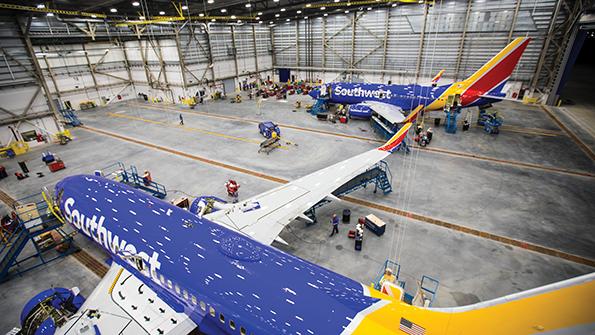
The U.S. FAA certificate management office (CMO) responsible for Southwest Airlines was wrong to allow the carrier to clear 88 used aircraft for service through what inspectors knew was a flawed conformity process, the agency admits, concurring with a Transportation Department audit that found several major shortcomings. The agency plans to act on 11 recommendations made by the auditors, including more training on root-cause analysis for addressing airworthiness issues.
“We agree that the Southwest Airlines (SWA) FAA Certificate Management Office (CMO) did not perform in accordance with existing guidance by allowing 88 aircraft (the ‘Skyline’ aircraft) to enter service through SWA’s conformity process, which lacked a comprehensive conformity inspection for used aircraft,” the agency says in a formal response to the report, released in early February.
Auditors also found that consistent reporting of inaccurate weight-and-balance figures to pilots disclosed by the airline was not handled correctly. “Regarding performance weight and balance, we agree the SWA CMO, at times, did not perform in accordance with existing guidance,” the FAA says.
The Skyline-aircraft issues involve 88 used Boeing 737s that Southwest bought in 2013-17. Southwest tapped consultants to review the aircraft records and verify specific items highlighted in Southwest’s “summary documentation,” the report says. But Southwest’s processes did not factor in certain unknowns, such as repairs with inaccurate or incomplete documentation, or paperwork that differed from FAA protocol. It also did not call for any independent records analysis, the Office of Inspector General (OIG) found. The 88 737 NGs were previously operated by airlines in China (23 aircraft), Canada (14), Argentina (14), Russia (10) and Mexico (9).
In late 2017, the FAA discovered potential gaps in Southwest’s aircraft-conformity process. In mid-2018, the agency discovered some of the airline’s used aircraft were in service without properly documented repairs and records that had not been translated into English. The agency and Southwest agreed to a plan, the Repair Assessment Program (RAP), under which all 88 would be inspected, all repairs validated, and any other issues resolved within two years. The FAA also began participating in Southwest’s conformity process.
The agency, facing pressure from lawmakers digging into airline oversight, later ordered Southwest to speed up the process, giving the airline a Jan. 31, 2020, deadline. As of Feb. 1, Southwest had confirmed that 80 of the affected aircraft completed the RAP, and eight others—all in heavy maintenance—were undergoing RAP inspections.
Inspectors in the Southwest CMO pointed to risk analysis done under the carrier’s FAA-approved safety management system (SMS) as justification for allowing the aircraft to keep flying during the RAP time frame. The OIG says the plan violated FAA regulations—specifically Part 121, Subpart H—and the two-year deadline for fixing the issues did not reflect the FAA’s Compliance Program philosophy that allows operators to “achieve rapid compliance” with the regulations.
The FAA plans to “ensure” that designated airworthiness representatives review and validate aircraft records and verify that they conform with U.S. standards. The agency also will issue inspector guidance on evaluating air carrier safety risk assessments, making sure SMS are not used “as a substitute for regulatory compliance,” the report says.
The agency will retrain Southwest CMO inspectors on proper use of voluntary disclosure processes and will develop guidance on evaluating risk assessments and root-cause analysis. The FAA also changed personnel in Southwest’s CMO last year.
On the weight-and-balance issue, the FAA learned in January 2018 that the carrier’s pilots were regularly receiving inaccurate data. Southwest self-disclosed using the FAA’s Voluntary Disclosure Reporting Program (VDRP). The FAA ordered the airline to audit 25% of its flights, investigate any findings that were inaccurate by 300 lb. or more, and report to the FAA discrepancies of at least 1,500 lb. “We found that inspectors did not ensure Southwest Airlines fulfilled its requirements or verify that the carrier took the agreed-upon actions,” the OIG says.
FAA rules require carriers to report “accurate” weight and balance data, but the term is not defined. Southwest’s risk analysis concluded that variances of up to 1,500 lb. were low-risk. It continued to use its VDRP to report discrepancies at a rate of 10-25 per month for two years and inaccuracies up to 7,000 lb. In some cases, multiple events were lumped into a single disclosure, This, the OIG says, violates FAA guidance.
“The FAA principal inspector deemed these actions acceptable because the airline justified inaccurate weight and balance calculations as a low risk,” the OIG says. “Additionally, the inspector stated handling the noncompliances in this manner would minimize the administrative burden within the local oversight office. These decisions indicate a need to ensure FAA inspectors in the local oversight office are trained on the purpose and proper use of VDRP.”
The OIG also took issue with the leeway granted to Southwest without a clear plan to solve the problem.
“FAA granted the carrier multiple extensions to determine the root cause and then granted additional time for the carrier to implement corrective actions, even though the principal inspector did not feel the carrier had identified the true cause,” the OIG says. “According to FAA managers, this was because they believed that the root-cause [analysis] is the responsibility of the carrier and the inspectors should not be involved in that process. However, these statements are contradictory to FAA guidance that requires inspectors to work with air carriers to determine the root cause of safety concerns.”
Southwest is working on making the process—which relies on handcounts of baggage and their positions on the aircraft—more accurate. “In addition to the increased surveillance by the SWA CMO, the airline integrated new technology to better manage its baggage count and is working to implement this technology with cargo as well,” the OIG says.
The OIG’s findings on root-cause analysis shortcomings dovetail with conclusions in a December 2019 report that focused on FAA oversight of Allegiant Air. That report recommended “a comprehensive review” and, if necessary, modifications to FAA root-cause analysis training for inspectors, which the agency plans to implement this year.


